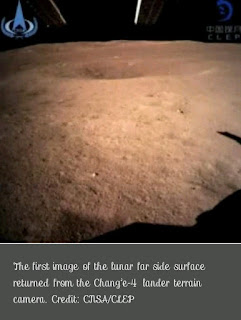 For the first time in history, a space mission has touched down on the far side of the moon. China's Chang'e-4 probe landed in the the oldest and deepest basin on the moon's surface. Making the mission a milestone for both China and space exploration as a whole.
For the first time in history, a space mission has touched down on the far side of the moon. China's Chang'e-4 probe landed in the the oldest and deepest basin on the moon's surface. Making the mission a milestone for both China and space exploration as a whole.
This isn't the first time China has landed on the moon. In 2013, Chang'e-3 successfully touched down on Mare Imbrium, a huge lava plane on the moon's surface. But until now, China has never explored the moon's mysterious dark side. No one has.
That's actually why it's called the "dark side". It's not hidden from the sun. It's hidden from our view. That's because the Earth and moon are in what's called synchronous rotation. Which means every time the moon rotates once on its axis, it also completes one orbit around the Earth.
It's impossible to communicate with anything over there. Any signal would get blocked by the rest of the moon. But China's team had a solution. They launched a relay satellite with a clear view of both Chang'e-4 and the Earth. And so far, the plan's working. Here are the very first images taken by Chang'e-4. The first in history ever taken from the surface on the dark side of the moon. What's more, you're looking at the oldest, largest, and deepest basin the moon has.
Chang'e-4 landed in Von Karman a flat landscape that sits inside: South Pole-Aitken basin. The basin is around 2500 km across that's about the distance from New York to Dallas! And it's a whopping 8 km deep for comparison, the deepest natural point on Earth, the Challenger Deep, is nearly 11 km deep. Next, the lander will release a rover that will explore the surrounding area. One of its tasks is to study the composition of rocks and dirt in the basin. Since scientists believe this is the oldest basin on the moon learning what it's made of might help us understand how Earth's only moon formed and evolved.
But that's only one goal of the mission. Besides cameras and spectrometers, Chang'e-4 also brought along potatoes and silkworm eggs. Researchers hope to test how well plants can grow and eggs can hatch in the moon's low gravity. It's the mini-first greenhouse to ever land on another world in our solar system and might help prepare us for space colonies in the future.